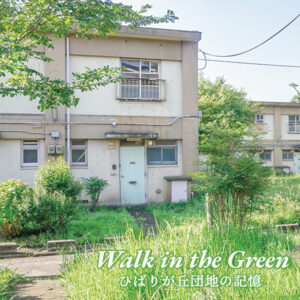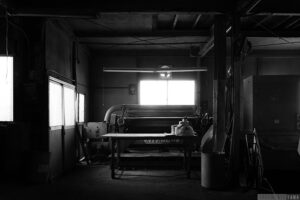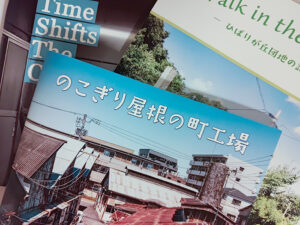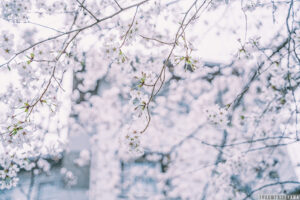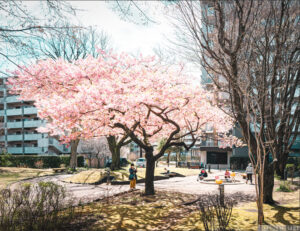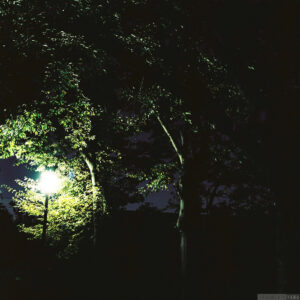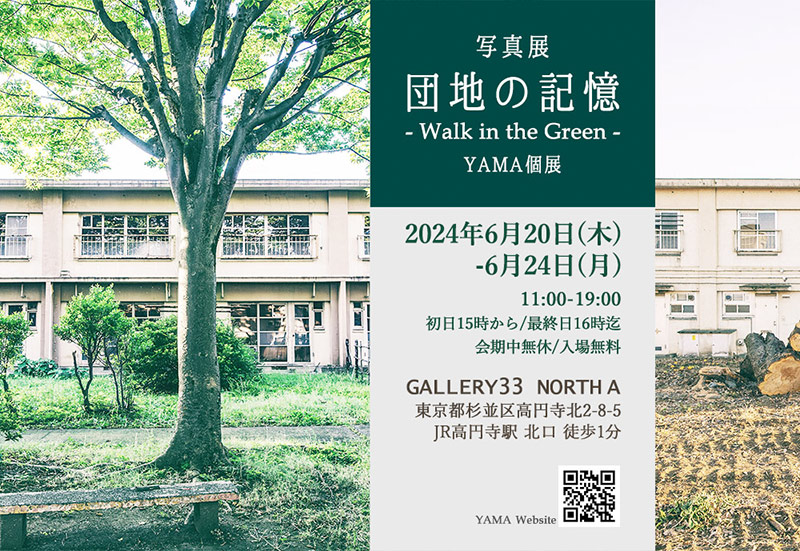
個展「団地の記憶 – Walk in the Green -」
2024年6月20日(木)~24日(月)
11:00-19:00 (初日15時から/最終日16時迄)
東京都杉並区高円寺北2丁目8−5
JR高円寺駅北口 徒歩1分
入場無料、会期中無休
ひばりが丘団地の旧テラスハウスの取り壊し前後の写真を中心に展示いたします。
団地の記憶 – Walk in the Green - (展示のご挨拶)
ひばりが丘団地テラスハウスの取り壊し前後の写真を中心に展示しています。ひばりが丘団地は1959年に造成され、東京都西東京市と東久留米市にまたがり総戸数は2714戸という大規模団地でした。
2012年、敷地の北側で建替えが行われました。
わたしが団地と出会ったのは2012年6月のことです。そこから1年間、残されていた南西側の中層フラット棟とテラスハウス(2階建て庭付き長屋住宅)の撮影を行いました。 すでに住人の退去がすすんでおり、人気がなくなるのに反比例するように植物がいきいきと繁茂していました。
団地が建つ前は、雑木林に松の木などが混在する原野だったといいます。
2001年当時、団地自治会会長である小林氏は「入居当時はバスもない、電車もない、雨が降ればぬかるみの道で『陸の孤島』とよばれていたこの団地を、今日のような花も緑も豊かで多くの人が第二の故郷と愛着を持つ団地に育ててきました」と語っています。
かつては武蔵野に雑木林はありませんでした。
玉川上水ができたことで新田開発がすすみ、人々が使う燃料および肥料を確保するために武蔵野台地に林がつくられました。団地造成時にはその自然を残すため工夫もされたようです。
戦時中、敷地の東側には昭和13年から操業開始した「中島航空金属田無製造所」が稼働しており、中島飛行機の武蔵製作所で使うエンジン部品が作られていました。小学校を卒業したばかりの少年工、朝鮮人、女子勤労挺身隊などが動員されて働かされていました。塩素ガスを使うのでまわりの松林はすっかり枯れてしまったといいます。当時田無製造所から東久留米駅まで敷設されていた引込線はカーブをえがきながらのちのひばりが丘団地の敷地をかすめるように通っていました。現在、その一部は遊歩道「たての緑地」となっています。
さまざまな緑の中を散歩するようにご覧いただければと思います。
※参考資料
「ひばりが丘団地自治会創立40周年記念」「創立50周年 ひばりが丘団地自治会」「田無市史 第3巻」「武蔵野市の雑木林の現状と課題(NPO法人 市民まちづくり会議・むさしの)」「戦争の記憶を武蔵野にたずねて」「田無の戦災誌」「武蔵野市女性史 あのころそのとき : 国策に絡め捕られて」「中島航空金属株式会社と田無」「戦時下の武蔵野1」、西東京市図書館所蔵資料等
Solo Exhibition “Memories of the Complex – Walk in the Green –“
Thursday, June 20 – Monday, June 24, 2024
11:00-19:00 (from 15:00 on the first day / until 16:00 on the last day)
GALLERY33 NORTH A
2-8-5 Koenji-kita, Suginami-ku, Tokyo
1 minute walk from JR Koenji Station North Exit
Admission free, open throughout the exhibition period
The exhibition will feature photographs taken before and after the demolition of the former terrace house in Hibarigaoka Danchi.
Memories of the Complex – Walk in the Green –
This exhibition focuses on photographs taken before and after the demolition of the terrace houses at the Hibari-ga-Oka housing complex. Built in 1959, the Hibari-ga-Oka housing complex was a large development spanning 2,714 units across Nishitokyo City and Higashikurume City in Tokyo.
In 2012, the northern part of the complex underwent reconstruction. I first encountered the complex in June 2012. For the following year, I photographed the remaining mid-rise flat buildings and terrace houses (two-story row houses with gardens) on the southwestern side. As residents continued to vacate, the lush growth of plants and trees stood in stark contrast to the decreasing human activity.
Before the complex was built, the area was a wilderness with mixed forests, including pine trees. In 2001, Mr. Kobayashi, the chairman of the residents’ association, reminisced, “When we moved in, there were no buses, no trains, and the roads turned muddy when it rained. This complex, once called an ‘isolated island,’ has grown into a place rich in flowers and greenery, cherished by many as a second home.”
Historically, there were no mixed forests in Musashino. With the construction of the Tamagawa Josui canal, new farmland development accelerated, and forests were created on the Musashino Plateau to secure fuel and fertilizer for the residents. Efforts were made to preserve this natural environment when the housing complex was developed.
During wartime, the eastern side of the site housed the Nakajima Aircraft Metalworks Tanashi Plant, which started operations in 1938. This plant produced engine parts for the Nakajima Aircraft Musashi Plant. Young boys who had just graduated from elementary school, Koreans, and women’s volunteer labor corps were mobilized to work there. The use of chlorine gas caused the surrounding pine forests to wither. A railway spur line laid from the Tanashi Plant to Higashikurume Station curved through what would later become the Hibari-ga-Oka housing complex. Today, part of this line is the “Tateno Ryokuchi” walkway.
I hope you enjoy this exhibition as if you were taking a stroll through the various green landscapes.
